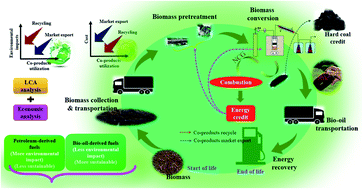Life cycle analysis (LCA) and economic evaluation of catalytic fast pyrolysis: implication of co-product's end-usage, catalyst type, and process parameters†
Abstract
The present study aimed to highlight the environmental performance and economic analysis of non-catalytic, Al2O3 catalyzed and Ni/Al2O3 catalyzed pyrolysis to obtain a more environmentally benign and cost-effective process. The study also emphasized the impact of including co-product recycling and market export on environmental load and process economics in different scenarios. The results elucidate that biochar exported for coal replacement to earn credits is more advantageous in reducing environmental impacts than the biochar recycled back to process to reduce natural gas usage, while the reverse is true from an economic point of view. Ni/Al2O3 catalyzed pyrolysis gives better results and lower environmental burden in comparison to Al2O3 catalyzed pyrolysis due to its better efficiency and capability to produce relatively high energy density bio-oil. Economic analysis also suggests the Ni/Al2O3 catalyzed process as a relatively cheaper process than the Al2O3 catalyzed process. Moreover, scenarios 2, 3 and 4 (which considered co-product back recycling/market export) bring significant reduction in the overall value of impacts compared to scenario 1 (which has no utilization of co-products), illustrating the environmental saving achieved from co-product utilization through market export and recycling. For instance, the global warming potential (GWP) of Al2O3 catalyzed pyrolysis has been reduced by approximately 42.42, 24.24 and 1.01% below the gasoline GWP, while Ni/Al2O3 decreased the GWP values by 54.54, 40.40 and 23.23%, for scenarios 2, 3 and 4, respectively. Thus, the lower environmental burden of catalytic pyrolysis derived bio-oil compared to that of petroleum fuels advocates the substitution of petroleum-based fuels with the more-environment friendly and renewable pyrolysis derived bio-oil.



 Please wait while we load your content...
Please wait while we load your content...